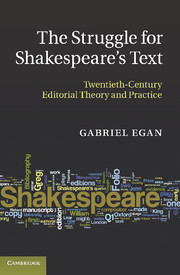Book contents
- Frontmatter
- Contents
- Preface
- Acknowledgements
- A note on references, quotations, names and pronouns
- Introduction
- 1 The fall of pessimism and the rise of New Bibliography, 1902–1942
- 2 New techniques and the Virginian School: New Bibliography 1939–1968
- 3 New Bibliography 1969–1979
- Intermezzo: the rise and fall of the theory of memorial reconstruction
- 4 New Bibliography critiqued and revised, 1980–1990
- 5 The ‘new’ New Bibliography: the Oxford Complete Works, 1978–1989
- 6 Materialism, unediting and version-editing, 1990–1999
- Conclusion: the twenty-first century
- Appendix 1 How early modern books were made: a brief guide
- Appendix 2 Table of Shakespeare editions up to 1623
- Appendix 3 Editorial principles of the major twentieth-century Shakespeare editions
- Works cited
- Index
6 - Materialism, unediting and version-editing, 1990–1999
Published online by Cambridge University Press: 06 December 2010
- Frontmatter
- Contents
- Preface
- Acknowledgements
- A note on references, quotations, names and pronouns
- Introduction
- 1 The fall of pessimism and the rise of New Bibliography, 1902–1942
- 2 New techniques and the Virginian School: New Bibliography 1939–1968
- 3 New Bibliography 1969–1979
- Intermezzo: the rise and fall of the theory of memorial reconstruction
- 4 New Bibliography critiqued and revised, 1980–1990
- 5 The ‘new’ New Bibliography: the Oxford Complete Works, 1978–1989
- 6 Materialism, unediting and version-editing, 1990–1999
- Conclusion: the twenty-first century
- Appendix 1 How early modern books were made: a brief guide
- Appendix 2 Table of Shakespeare editions up to 1623
- Appendix 3 Editorial principles of the major twentieth-century Shakespeare editions
- Works cited
- Index
Summary
By the early 1990s the New Textualism was unmistakably a movement across a broad front. Uniting scholars of criticism and textual study and drawing upon post-structuralism's confrontation with traditional criticism, the movement aimed to raise the status of early editions that New Bibliography had denigrated, the non-substantive ones and especially the bad quartos. There was an underlying political element to the movement, but it was seldom more overtly expressed than in Leah S. Marcus's use of the term levelling to draw an analogy between on one hand the recent critical interest in the lower classes, the marginalized, and the radical seventeenth-century Leveller movement, and on the other New Textualism's impatience with hierarchical distinctions between substantive and non-substantive editions. The expression equal-but-different from gender politics of the 1970s was adapted: the previously derided editions should be thought of as ‘different instead of debased’ (Marcus 1991, 168). She sought to show that there is no need to rank the early editions of a play because – as argued by Steven Urkowitz in connection with the bad quartos of The Contention of York and Lancaster and Richard Duke of York (pp. 116–17 above) – each is a distinct and internally coherent version. In an argument she expanded for her book Unediting the Renaissance (Marcus 1996, 68–100), Marcus argued that the Folio and quarto editions of The Merry Wives of Windsor are separated most fundamentally not by textual corruption but, rather like Q and F King Lear, by conscious artistic reshaping.
- Type
- Chapter
- Information
- The Struggle for Shakespeare's TextTwentieth-Century Editorial Theory and Practice, pp. 190 - 206Publisher: Cambridge University PressPrint publication year: 2010



